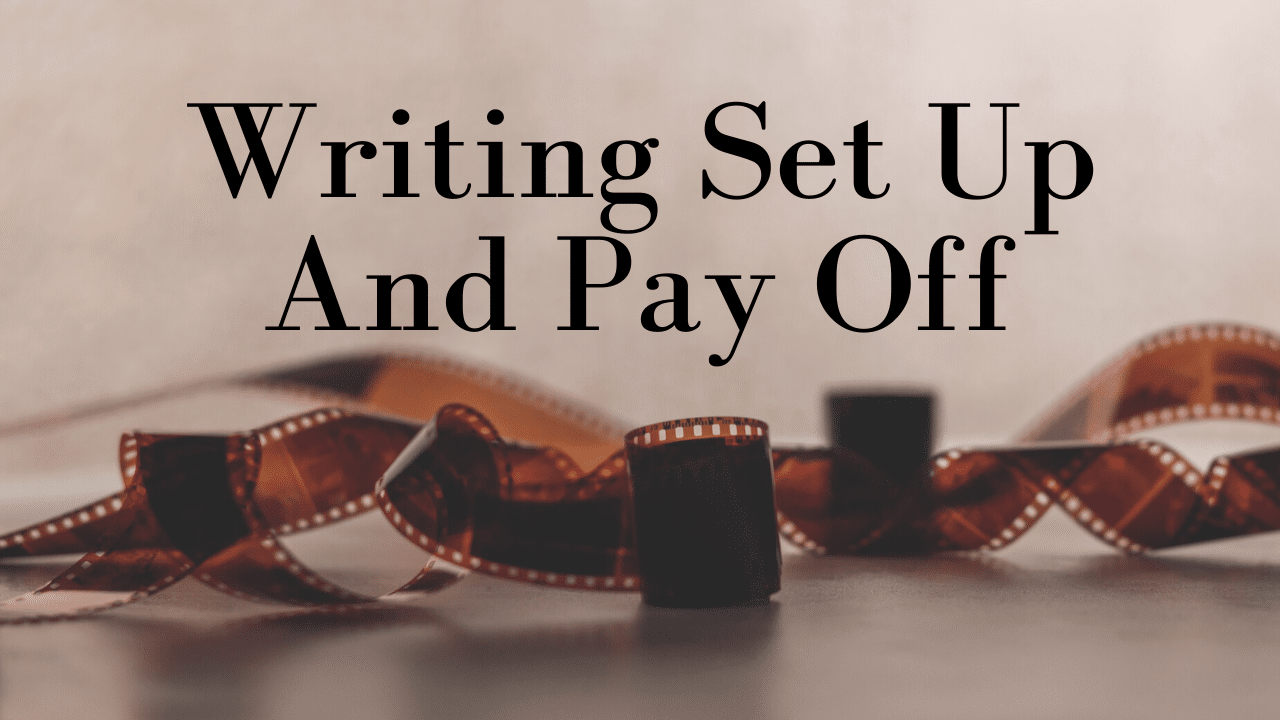As an Amazon Associate I earn from qualifying purchases.
Written by JJ Barnes
Set up and pay off is a writing technique to make your story feel satisfying. You put something in the earlier part of your story which, in and of itself, makes sense as an isolated moment. Then use that moment later in the story to greater effect. You pay off your audience for noticing and remembering it.
The Effect Of Set Up And Pay Off
Set up and pay off used well makes your story more satisfying.
Including set up and pay off means your audience feels rewarded for paying attention. Those early set up notes are put in just for their enjoyment. Without them the story would still make sense. Paying them off enhances the story climax, and makes your audience have a better experience.

Die Hard

I’m going to be using a couple of examples from the film Die Hard to demonstrate the use and effect of set up and pay off.
If you haven’t seen it, this includes massive spoilers. If you have, you’ll recognise the examples. It should start to form a clearer understanding of different ways of using this technique in your story, and why it is such a good thing to do.
Set Up And Pay Off With The Watch
John McClane goes to Nakatomi Tower. His story goal is to win back the love of his ex wife Holly. She introduces him to Ellie, your classic 80’s movie scumbag, and romantic antagonist to John McClane.
Ellis wants to taunt John about how successful Holly is without him. He tells Holly to show him the watch she was given by the company as a reward. He tells John that he and his company are superior to John. That he wouldn’t be able to compete with them and give her anything as nice as that watch and the life she has there in LA.
The watch at the beginning of the film is paid off beautifully at the very end of the movie. Hans Gruber is hanging out of the window of the building, clinging onto Holly’s arm so she might fall out too. The way John stops him and saves the day is to unclip the watch. In that moment, the offensive watch, and the offensive villain, go plummeting downwards in the iconic scene we all know and love.
Using the watch in this way solves the problem of the villain, and it feels like John is getting emotional catharsis for the company attempting to lure her away from him. They can give her a fancy watch, but he can save her life.


Set Up And Pay Off With Al’s Gun
On the outside of the tower, policeman Al is helping John McClane via walkie talkie. He tells John a story about why he was given a desk job after accidentally shooting a kid who was holding a toy gun. Since that day, he has been unable to fire his weapon. It’s an emotional story that connects John and Al, and shows his vulnerability.
At the end of the film, when John and Holly have finally escaped Nakatomi Tower, and it seems like everyone is now safe, another terrorist comes running out, and goes to shoot John. He is then shot, before he can hurt anyone, and you then are shown that is was Al who shot him. It’s a powerful moment, and obviously means a lot to Al, and John understands why it does.
This set up and pay off moment is a sign of why this film is unnecessarily good. Al is essentially a side character. He providing support for the lead. But they have still taken the time and care to not only give him a character arc, but with this very clever and emotionally effective set up and pay off style.
The Impact

The film would have worked just fine had he won by throwing Hans Gruber off the roof to protect Holly. You’d still get the same shot of him falling. It would have worked fine if Al hadn’t been through the trauma and had just shot the terrorist to protect John.
The film would have worked fine, the plot would have essentially remained the same. But it wouldn’t hold such high standing in people’s hearts. It’s because the time and dedication was taken. Because the audience’s satisfaction was prioritised.
When you’re looking to achieve something similar in your own story, remember that you’re making this effort for your audience not for yourself. You can still tell your choice of story, with your choice of characters, without putting the time into the set up and pay off, but your audience won’t enjoy it as much.
Even if they don’t realise what it is they’re appreciating, they will realise you have taken this time and respected them enough to go to the trouble. You should love your audience enough to do that.

Editing Set Up And Pay Off Into Your Story
The key is to, when you reach the end of your story, if anything is plot relevant go back and seed it into your story early. Or, if you’re looking for something to use in a climax moment, go and look into the earlier part of your story and find something you’ve already placed there as scenery or in a moment between characters.
Then, you can grow that and you’ll find that it enhances other aspects of your story because when things become more relevant and interesting, the story grows around them to accommodate them and thus becomes richer because of it.
More From JJ Barnes:
I am an author, filmmaker, artist and youtuber, and I am the creator and editor of The Table Read.
You can find links to all my work and social media on my website: www.jjbarnes.co.uk
Buy my books: www.sirenstories.co.uk/books
Follow me on Twitter: @JudieannRose
Amazon and the Amazon logo are trademarks of Amazon.com, Inc, or its affiliates.


